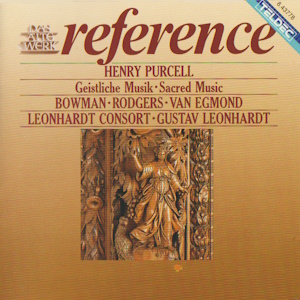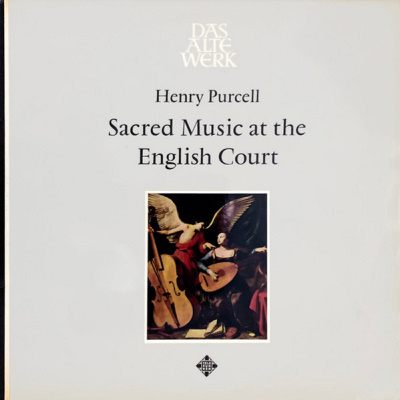 |
| 1 CD -
8.43778 ZS - (c) 1987 |
 |
1 LP -
SAWT 9558-B - (p) 1970
|
|
GEISTLICHE MUSIK AN ENGLISCHEN
KÖNIGSHOF
|
|
|
|
|
|
|
|
|
|
| Henry PURCELL
(1659-1695) |
Rejoice
in the Lord alway, Z 49 - Anthem for
3/4-part choir, strings and
continuo (organ) |
|
8' 50" |
1 |
A1
|
|
Blow up
the trumpet in Sion, Z 10
- Anthem for 9-part choir and organ |
|
7' 41" |
2 |
A2
|
|
O God,
Thou art my God, Z 35
- Anthem for 5-èart choir and continuo
(violoncello and organ) |
|
4' 11" |
3 |
A3
|
|
Chaconne, Z 730 - for 3 violins and
continuo (violoncello and organ)
|
|
5' 02" |
4 |
A4
|
|
O God,
Thou hast cast us out, Z 136
- Anthem for 6-part choir and continuo
(violoncello and organ) |
|
4' 27" |
5 |
B1
|
|
My
heart is inditing, Z 30
- Anthem for 8-part double choir,
strings and continuo (organ) |
|
16' 37" |
6 |
B2
|
|
-
Composed for the coronation of King
James II in Westminster Abbey, the 23rd,
of April 1685. |
|
|
|
|
|
Remember
not, Lord, our offences, Z 50
- Anthem for 5-part choir (a cappella) |
|
3' 01" |
7 |
B3
|
|
|
|
|
|
James Bowman, countertenor
Nigel Rogers, tenor
Max van Egmond, bass
CHOIR OF KING'S COLLEGE CAMBRIDGE
David N. Willcocks, Chorus
master |
LEONHARDT-CONSORT (with
period instruments)
- Marie
Leonhardt, baroque
violin (Jacob Stainer, Absam 1676)
-
Antoinette van den Hombergh, baroque
violin (Klotz, Mittenwald 18th century)
- Janine
Rubinlicht, baroque
violin (Maggini School, Brescia 17th
century)
- Sigiswald
Kuijken, baroque
violin (Venice 18th century)
- Wim ten
Have, baroque
viola (Giovanni Tononi, 17th century)
- Lodewijk
de Boer, baroque
viola (German, 18th century)
- Dijck
Koster, baroque
violoncello (Giovanni Battista [II]
Guadagnini, 1749)
- Fred
Nijenhuis, violone
(German, end of 18th century)
- Gustav
Leonhardt, organ
(Klaus Becker, Kupfermühle [8', 4', 2', all
registers in wood, old tuning])
Gustav LEONHARDT, direction |
|
|
|
|
Luogo
e data di registrazione |
|
Hervormde
Kerk, Bennebroek (Holland) -
Juni / July 1969 |
|
|
Registrazione:
live / studio |
|
studio |
|
|
Producer |
|
Wolf
Erichson
|
|
|
Prima Edizione
LP |
|
Telefunken
- SAWT 9558-B - (1 LP) - durata
50' 32" - (p) 1970 - Analogico
|
|
|
Edizione
"Reference" CD
|
|
Tedec
- 8.43778 ZS - (1 CD) - LC 3706 -
durata 50' 32" - (c) 1987 - AAD |
|
|
Cover |
|
Detail
aus einem barocken Bilderrahmen
mit König David, Musen, Tugenden
und Lastem. Buchsbaumholz /
Holland gegen 1670, mit
freundlicher Genehmigung des
Museums für Kunst und Gewerbe,
Hamburg
|
|
|
Note |
|
-
|
|
|
|
|
Of the 69
anthems that were
written by Henry
Purcell, more than
half were composed
during the reign
of Charles II, the
earliest probably
around 1678. It
was during this
period that
Purcell rose from
a position as
composer for the
royal violins to
one as organist at
Westminster Abbey
and finally to an
appointment as
keeper of the wind
instruments at the
Chapel Royal.
These anthems may,
then, be
considered early
works, but already
show Purcell's
outstanding
ability to
elucidate the
meaning of the
words by his
handling of the
text.
The selection of
Purcell's sacred
works presented
here covers the
period from
1680-1685. The
5-part full anthem
“Remember not,
Lord, our
offences”, written
1680/82 on a text
from the Anglican
Book of Common
Prayer, is an
example of
Purcell’s regard
for the
established
Elizabethan
traditions.
Fashioned for the
sheer beauty of
its sound, it is a
purely vocal motet
in the old style.
The principles of
imitation are
fundamental to its
construction. In
addition, we find
highly chromatic
passages used to
great effect. The
section “Neither
take Thou
vengeance of our
sins” is
reminiscent of the
well-known German
hymn tune “O
sacred head, sore
wounded,” though
this is probably
just coincidental.
The 6-part anthem
“O God Thou hast
cast us out”
(1680/82), Psalm
60 verses 1, 2; 11
and 12, may also
be classified as
“the old style,”
even though a
basso continuo
accompaniment
makes its
appearance. The
opening and
closing sections
of this anthem are
particularly
impressive, the
former for the
reiterated cry “O
God” and the
latter for its
depiction of the
final victory
emphasised by the
fugal treatment of
the words “tread
down our enemies.”
The setting of
Psalm 63 verses
1-4 and 7, “O God,
Thou art my God”
(1680/82) is a
full anthem in the
new style. That is
to say, it is a
choral anthem with
two 3-part solo
verse sections,
and basso
continuo. These
“verses,” with
their profusion of
thirds, typical of
many anthems and
already almost
stereotyped in
their form, (e. g.
part four “For Thy
loving kindness”)
provide a contrast
to the powerful
solid block
harmony of the
choral passages.
Parts five and six
are scored for
double chorus.
Section six is a
setting of the
Allelujah, which
from now on became
an almost
traditional
appendage to an
anthem. Likewise
in the new style
is the anthem
“Blow up the
trumpet in Sion”
(c. 1681), Joel 2,
15-17. Here we see
how brilliantly
Purcell deploys
several choral
groups; with the
utmost mastery and
virtuosity he uses
the various
combinations which
then offer
themselves. The
sound of the
trumpet is
depicted not only
by the parts
moving in thirds
but also by the
rhythm - in fact
the rhythmic
element is of
supreme importance
for the work and
the tremendous
effect it creates.
While the above
mentioned full
anthems were
composed by
Purcell in his
capacity as
organist at
Westminster Abbey
(till 1683), a
church with both
an organ of note
and an excellent
choir, the two
verse anthems,
“Rejoice in the
Lord alway”
(1684/85) and “My
heart is inditing”
(1685), were
written by him in
connection with
his work with the
Chapel Royal,
which is reflected
in their courtly
style, in their
scope and design.
In these “cantata”
anthems the solo
and instrumental
passages take
precedence over
the choral, for
the Chapel Royal
had the services
of fine vocal and
instrumental
soloists whose
talents were,
naturally,
exploited to the
full. Thus the
first of these two
verse-anthems has
only one choral
passage, which is
repeated at the
end of the work -
of its eleven
sections only two
are allotted to
the choir. The
constant
recurrence of the
12-bar theme in
practically every
section musically
underlines the
message of the
text “Rejoice
alway”
(Philippians 4,
4-7). This
composition also
goes under the
name of the “Bell
Anthem,” so called
because of the
bell-like passage
on a ground bass
on the
instrumental
introduction.
Perhaps the most
splendid and
impressive of all
Purcell’s anthems
is the one written
for the coronation
of James II, 23rd.
of April 1685, “My
heart is
inditing.” The
text is taken from
Psalm 45 and
Isaiah 49 and it
is scored for
8-part choir,
soloists and
string orchestra.
Contemporary
accounts tell us
that it was
performed while
the Queen was
being led to her
throne after the
annointing and
crowning
ceremonies. The
anthem is one
continual hymn of
praise interrupted
only by the
contemplative
section “Hearken,
O daughter,
consider” rendered
by the soloist
ensemble. The work
ends with a
magnificently
conceived
“Allelujah Amen,”
pointing the way
to Handel’s famous
chorus.
The Chaconne for
three violins and
continuo in G
minor is an
example both of
Purcell’s
full-sounding
instrumental style
and also of
late-17th. century
English music as a
whole.
Christoph-Hellmut
Mahling
|
|